|
|
#701 |
|
⊙▃⊙
|
What's in the sky tonight?
October 9, 2013 -An interplanetary shock wave, possibly the leading edge of a CME, hit Earth's magnetic field on October 8th at approximately 2015 UT (1:15 pm PDT). The impact sparked a G1-class geomagnetic storm (in progress) and bright auroras around the Arctic Circle. Lana Rupp photographed the "stunning display of color" over Borgarnes, Iceland, during the early hours of Oct. 9th below. Earth is passing through the wake of the CME where a region of high-speed solar wind continues to buffet our planet's magnetic field. NOAA forecasters, who suspect that a second CME might arrive on Oct. 9th, estimate a 65% chance of polar geomagnetic storms during the next 24 hours. High-latitude sky watchers should remain alert for auroras. -Solar activity is picking up. New sunspot AR1865 erupted this morning (Oct. 9th at 01:48 UT), producing the strongest solar flare in nearly two months. NASA's Solar Dynamics Observatory recorded the M2.8-class eruption: movie. Earth was not in the line of fire, but future eruptions could be geoeffective as the sunspot turns toward our planet in the days ahead. -Look for Venus far lower right of the Moon during and after twilight. Just 3/4° above Venus is 2nd-magnitude Delta Scorpii. 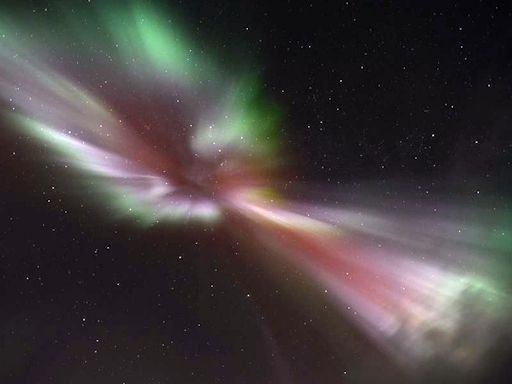 Astro Picture of the Day: October 9, 2013 During the night time hours of October 8, a minor Coronal Mass Ejection (CME) impacted the magnetic field of the Earth. The impact sparked a G1-class geomagnetic storm where the northern lights could be seen as far south as Ohio. If you are a northern latitude watcher, you were given the best show however. This photo, by B.Art Braafhart of Salla, Finnish-Lapland, had front row seats to a particular intense section of the storm that pierced not only through an otherwise overcast night, but also illuminated the lake in eerie tones of green. Braafhart estimates that the storm he witnessed peaked at a Kp index of 6.33 as opposed to 5. The overcast sky contributes significantly to the eerie effect of this image. Tonight, there is a 65% chance that strong geomagnetic activity continues.
__________________
1st in Kommisar's 2009 SM Tournament 1st in I Love You`s 2009 New Year`s Tournament 3rd in EnR's Mashfest '08 tournament 5th in Phynx's Unofficial FFR Tournament 9th in D3 of the 2008-2009 4th Official FFR Tournament 10th in D5 of the 2010 5th Official FFR Tournament 10th in D6 of the 2011-2012 6th Official FFR Tournament FMO AAA Count: 71 FGO AAA Count: 10 Bluearrowll = The Canadian player who can not detect awkward patterns. If it's awkward for most people, it's normal for Terry. If the file is difficult but super straight forward, he has issues. If he's AAAing a FGO but then heard that his favorite Hockey team was losing by a point, Hockey > FFR PS: Cool AAA's Terry - I Love You An Alarm Clock's Haiku beep beep beep beep beep beep beep beep beep beep beep beep beep beep beep beep beep - ieatyourlvllol |
|
|

|
|
|
#702 |
|
⊙▃⊙
|
What's in the sky tonight?
October 10, 2013 -Mercury (magnitude –0.1) remains deep in the glow of sunset. About 30 minutes after sunset, use binoculars to look for it 20° lower right of Venus -Comet ISON is not the only comet diving toward the sun. Another smaller comet is feeling the heat today. Using a coronagraph to block the sun's glare, the Solar and Heliospheric Observatory (SOHO) is monitoring the comet's death plunge. This comet is a member of the Kreutz family. Seen falling into the sun dozens of times each year, Kreutz sungrazers are fragments from the breakup of a single giant comet many centuries ago. They get their name from 19th century German astronomer Heinrich Kreutz, who studied them in detail. -Today's sungrazer is probably doomed. The vast majority of Kreutz comets are small (no more than ~10 m wide) and they evaporate completely as they approach the sun. Comet ISON, on the other hand, is large (~0.5 km wide) and widely expected to survive its brush with the sun on Nov. 28th. -Yesterday, NASA's Juno spacecraft buzzed Earth only 347 miles above our planet's surface. It was a slingshot maneuver designed to gain velocity for Juno's long trip to Jupiter (ETA: 2016). Although the spacecraft was very faint, several amateur astronomers managed to photograph it. The spacecraft is now hurtling away from Earth at 23,500 mph. Bon voyage, Juno! Find Juno Spacecraft photos here: http://spaceweathergallery.com/index.php?title=juno 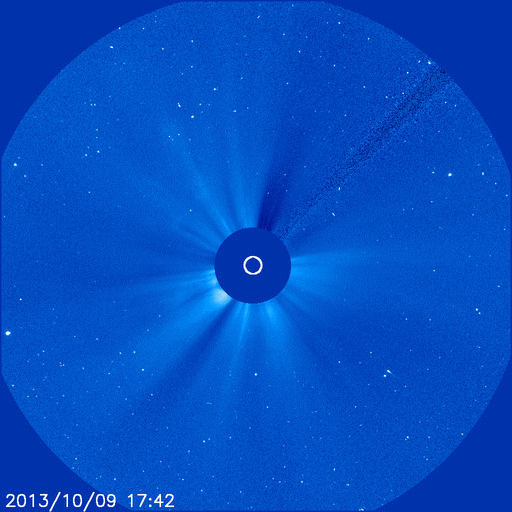 Astro Picture of the Day: October 10, 2013 An interplanetary shock wave, possibly the leading edge of a CME, hit Earth's magnetic field on October 8th at approximately 2015 UT. The impact sparked a G1-class geomagnetic storm and bright auroras around the Arctic Circle. Harald Albrigtsen sends this picture from Tromsĝ, Norway. Solar wind speeds remain elevated (~450 km/s) as Earth exits the wake of the CME. As a result, NOAA forecasters estimate a 40% chance of polar geomagnetic storms on Oct. 10th. The photo itself is a 10 second exposure at ISO 1600 acording to the photgorapher. During geomagnetic storms, the northern lights are easily luminous enough to reflect in still water.
__________________
1st in Kommisar's 2009 SM Tournament 1st in I Love You`s 2009 New Year`s Tournament 3rd in EnR's Mashfest '08 tournament 5th in Phynx's Unofficial FFR Tournament 9th in D3 of the 2008-2009 4th Official FFR Tournament 10th in D5 of the 2010 5th Official FFR Tournament 10th in D6 of the 2011-2012 6th Official FFR Tournament FMO AAA Count: 71 FGO AAA Count: 10 Bluearrowll = The Canadian player who can not detect awkward patterns. If it's awkward for most people, it's normal for Terry. If the file is difficult but super straight forward, he has issues. If he's AAAing a FGO but then heard that his favorite Hockey team was losing by a point, Hockey > FFR PS: Cool AAA's Terry - I Love You An Alarm Clock's Haiku beep beep beep beep beep beep beep beep beep beep beep beep beep beep beep beep beep - ieatyourlvllol |
|
|

|
|
|
#703 |
|
⊙▃⊙
|
What's in the sky tonight?
October 11, 2013 -The Kreutz sungrazer plunged into the sun yesterday - but it did not come out again. The icy visitor from the outer solar system was blasted by solar heat and completely destroyed. SOHO recorded the doomed comet's last moments -Radio amateurs, have you heard any strange roaring sounds coming from the loudspeakers of your shortwave radios this week? It might have been the sun. "The Sun has been generating Type III solar radio bursts and they appear to be intensifying," reports amateur radio astronomer Thomas Ashcraft of New Mexico. "The strongest burst so far came at 2155 UTC on October 9th." Ashcraft recommends listening to the audio using stereo headphones. "Type III bursts drift downward in frequency," he explains. "In stereo you can hear the burst pass through 28 MHz first on one speaker and then flow through 21 MHz on the other sound speaker." Type III solar radio bursts are produced by electrons accelerated to high energies (1 to 100 keV) by solar flares. As the electrons stream outward from the sun, they excite plasma oscillations and radio waves in the sun's atmosphere. When these radio waves head in the direction of Earth, they make themselves heard in the loudspeakers of shortwave radios around the dayside of the planet. More radio bursts could be in the offing. NOAA forecasters estimate a 30% chance of M-class flares and a 5% chance of X-class flares during the next 24 hours. The audio of the radio burst can be found here: [caution: will get loud] http://www.spaceweather.com/images20...1_Ashcraft.mp3 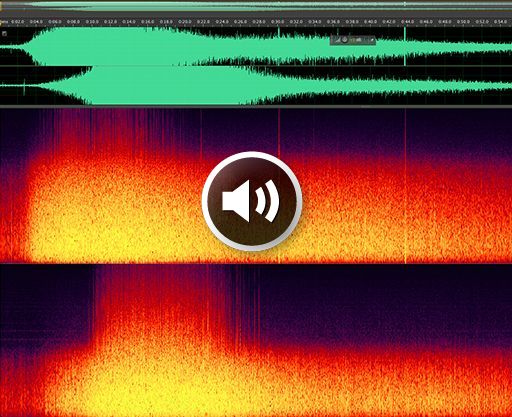 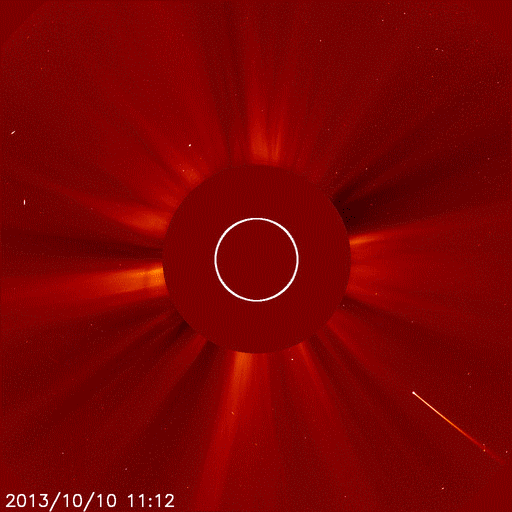 Astro Picture of the Day: October 11, 2013 If you have a solar telescope, depending on where you live, you have access to a day long show in that of the sun. This year is a particularly interesting year in the advent of solar maximum, albeit the weakest solar maximum in 100 years. However, there is speculation that this solar max will be double peaked, where the first peak has already passed us and we're presently in a lull. It's just a matter of time under this theory that the sun picks up again, and early speculation appears to be such that it may be picking right back up again. Here is a look at the AR1864 and AR1865 from 10:54 to 11:54UT by an amateur astronomer. Seeing was generally poor, but equipment used was an SM90 and DMK51 mono camera.
__________________
1st in Kommisar's 2009 SM Tournament 1st in I Love You`s 2009 New Year`s Tournament 3rd in EnR's Mashfest '08 tournament 5th in Phynx's Unofficial FFR Tournament 9th in D3 of the 2008-2009 4th Official FFR Tournament 10th in D5 of the 2010 5th Official FFR Tournament 10th in D6 of the 2011-2012 6th Official FFR Tournament FMO AAA Count: 71 FGO AAA Count: 10 Bluearrowll = The Canadian player who can not detect awkward patterns. If it's awkward for most people, it's normal for Terry. If the file is difficult but super straight forward, he has issues. If he's AAAing a FGO but then heard that his favorite Hockey team was losing by a point, Hockey > FFR PS: Cool AAA's Terry - I Love You An Alarm Clock's Haiku beep beep beep beep beep beep beep beep beep beep beep beep beep beep beep beep beep - ieatyourlvllol Last edited by Bluearrowll; 10-11-2013 at 02:57 PM.. |
|
|

|
|
|
#704 |
|
⊙▃⊙
|
What's in the sky tonight?
October 12, 2013 -Sunspot AR1861 is pointing directly at Earth and crackling with C-class solar flares. Bigger eruptions could be in the offing. The sunspot has a 'beta-gamma-delta' magnetic field that could erupt at any time. NOAA forecasters estimate a 40% chance of M-class flares and a 15% chance of X-flares on Oct. 12th. -Venus has been approaching much dimmer Antares, which twinkles to Venus's left in the southwest in evening twilight. They're now 4½° apart. They'll pass 1½° from each other on Wednesday. Astro Picture of the Day: October 12, 2013 Yesterday, A rare case of three moons — Io, Europa, and Callisto — casting their tiny black shadows onto Jupiter at once happened late last night, from 4:32 to 5:37 Universal Time October 12th (12:32 to 1:37 a.m. Saturday morning Eastern Daylight Time). Jupiter was high and best placed for telescope users in Europe and Africa, and low in the eastern sky for eastern North America. This is the same as having 3 lunar eclipses happening at the same time on the planet. This photo in particular is from Günther Strauch of Borken, Germany.
__________________
1st in Kommisar's 2009 SM Tournament 1st in I Love You`s 2009 New Year`s Tournament 3rd in EnR's Mashfest '08 tournament 5th in Phynx's Unofficial FFR Tournament 9th in D3 of the 2008-2009 4th Official FFR Tournament 10th in D5 of the 2010 5th Official FFR Tournament 10th in D6 of the 2011-2012 6th Official FFR Tournament FMO AAA Count: 71 FGO AAA Count: 10 Bluearrowll = The Canadian player who can not detect awkward patterns. If it's awkward for most people, it's normal for Terry. If the file is difficult but super straight forward, he has issues. If he's AAAing a FGO but then heard that his favorite Hockey team was losing by a point, Hockey > FFR PS: Cool AAA's Terry - I Love You An Alarm Clock's Haiku beep beep beep beep beep beep beep beep beep beep beep beep beep beep beep beep beep - ieatyourlvllol |
|
|

|
|
|
#705 |
|
⊙▃⊙
|
What's in the sky tonight?
October 13, 2013 -Earth is entering the outskirts of a debris stream from Halley's comet, source of the annual Orionid meteor shower. Last night, Oct. 12th, cameras in NASA's All-Sky Fireball Network detected two bright Orionid fireballs over the United States. The shower is expected to peak this year on Oct. 21st with ~20 meteors per hour between local midnight and dawn. An almost-full Moon on peak night will sharply reduce visibility, so watch out for the early Orionids. They might be the only ones you see. The Fireball network is outlined in the map below. -The zenith star soon after dark (for skywatchers at mid-northern latitudes) is no longer Vega but Deneb. It will remain there for weeks to come, since night is falling earlier and earlier all the time — counteracting the westward turning of the constellations if you observe at nightfall. Astro Picture of the Day: October 13, 2013 The triple transit Jupiter experienced October 12th was seen throughout most of Europe and parts of North America. This movie from Kocaeli, TURKEY was taken by Ahmet Kale between 7:20am - 8:00am. He writes, "It was very cloudy that night, but I waited patiently until the morning to find an opportunity to take this special moment. I was lucky, clouds gone just before the event started and I managed to capture this events first 30 minutes. The Sun was at about 10 degree high, So I just use 742 nm IR filter." Equipment he used consisted of a C11 EdgeHD on CGEM DX telescope, ZWO ASI 120MM camera, Astronomik ProPlanet IR742 Filter, and 34 x 1 minute captures at 150fps. The key to this capture was the filter. The ProPlanet IR 742 only allows infrared light with wavelengths of more than 742 nm to pass. In this wavelength range the effects of seeing are significantly lower than in the visible spectrum of the human eye. This allows much sharper images than are usually obtained from your device and location. Another advantage is that the sky background of advanced dawn is dark and so the filter even allows photography of the planets and the moon at daylight. This series of photos was taken well after sunrise due to clouds, and would not have been possible without this piece of equipment.
__________________
1st in Kommisar's 2009 SM Tournament 1st in I Love You`s 2009 New Year`s Tournament 3rd in EnR's Mashfest '08 tournament 5th in Phynx's Unofficial FFR Tournament 9th in D3 of the 2008-2009 4th Official FFR Tournament 10th in D5 of the 2010 5th Official FFR Tournament 10th in D6 of the 2011-2012 6th Official FFR Tournament FMO AAA Count: 71 FGO AAA Count: 10 Bluearrowll = The Canadian player who can not detect awkward patterns. If it's awkward for most people, it's normal for Terry. If the file is difficult but super straight forward, he has issues. If he's AAAing a FGO but then heard that his favorite Hockey team was losing by a point, Hockey > FFR PS: Cool AAA's Terry - I Love You An Alarm Clock's Haiku beep beep beep beep beep beep beep beep beep beep beep beep beep beep beep beep beep - ieatyourlvllol |
|
|

|
|
|
#706 |
|
⊙▃⊙
|
What's in the sky tonight?
October 14, 2013 -Mars, the 1st-magnitude star Regulus, and Comet ISON have gathered together in the pre-dawn sky only a few degrees apart. Comet ISON is invisible to the naked eye, but Mars and Regulus are bright enough to see without optics. They form a pretty red-blue "double star" that can lead telescopic observers to the comet. -October 13th began with an explosion on the sun. At 00:43 UT, sunspot AR1865 erupted, producing an M1-class solar flare and an Earth-directed CME. 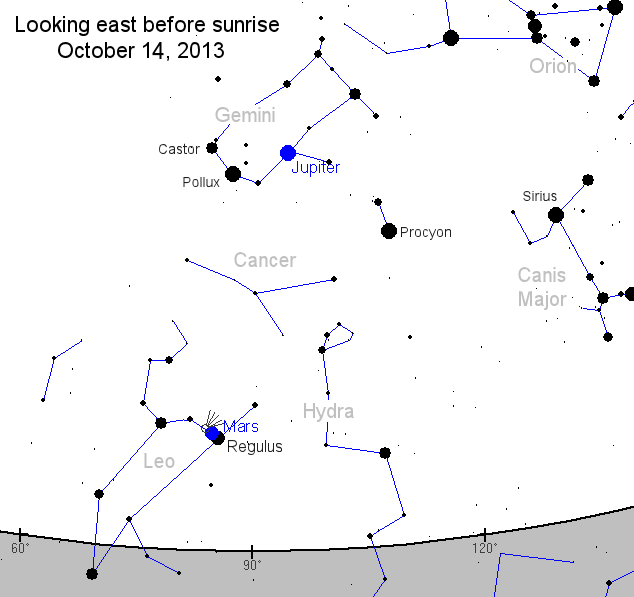 News Posted Today: October 13, 2013 Warm Glow from an Orphaned Planet  Astro Picture of the Day: October 14, 2013 A pair of sunspot groups in the sun's southern hemisphere poses a threat for Earth-directed eruptions. They're photogenic, too. Alex Dzierba took this picture of the sunspots rising over Koko crater in Honolulu, Hawaii, on Oct. 13th. He used a Coronado Personal Solar Telescope with a Ca/K filter. Ca/k or "Calcium K" filters are sensitive to light from ionized calcium in the sun's atmosphere. This kind of light reveals the bright magnetic froth around sunspots - and these sunspots are very frothy indeed. Sunrises in the week ahead could be punctuated by eruptions. NOAA forecasters estimate a 40% chance of M-class flares and a 10% chance of X-flares on Oct. 14th.
__________________
1st in Kommisar's 2009 SM Tournament 1st in I Love You`s 2009 New Year`s Tournament 3rd in EnR's Mashfest '08 tournament 5th in Phynx's Unofficial FFR Tournament 9th in D3 of the 2008-2009 4th Official FFR Tournament 10th in D5 of the 2010 5th Official FFR Tournament 10th in D6 of the 2011-2012 6th Official FFR Tournament FMO AAA Count: 71 FGO AAA Count: 10 Bluearrowll = The Canadian player who can not detect awkward patterns. If it's awkward for most people, it's normal for Terry. If the file is difficult but super straight forward, he has issues. If he's AAAing a FGO but then heard that his favorite Hockey team was losing by a point, Hockey > FFR PS: Cool AAA's Terry - I Love You An Alarm Clock's Haiku beep beep beep beep beep beep beep beep beep beep beep beep beep beep beep beep beep - ieatyourlvllol |
|
|

|
|
|
#707 |
|
⊙▃⊙
|
What's in the sky tonight?
October 15, 2013 -The upper-right edge of the Great Square of Pegasus points down at the Moon this evening. -As expected, a CME hit Earth's magnetic field this morning, Oct. 15th @ 10:00 UT. Earth was already surrounded by a gusty stream of solar wind when the CME arrived, so the signature of the CME's impact was almost indiscernable. Nevertheless, Arctic sky watchers got an eyeful. The solar wind stream itself fueled a fine display of auroras. 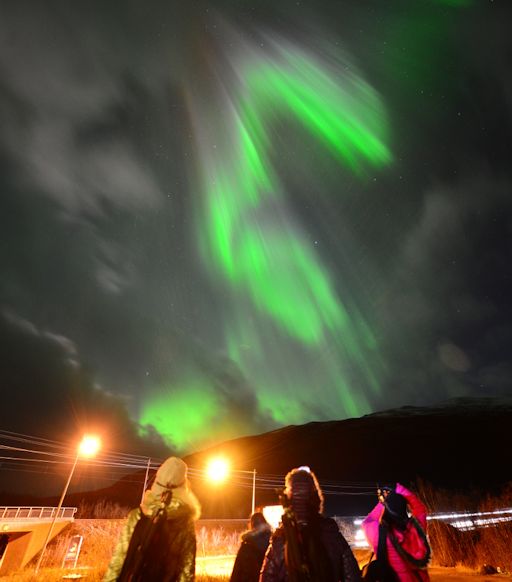 Astro Picture of the Day: October 15, 2013 How do you find Comet ISON? Wake up before dawn, face east, and follow the "double star." Rising about three hours before the sun, red Mars and blue-white Regulus have converged to form a bright pair separated by only 1o. Martin Gembec photographed the duo from the Czech Republic before daybreak on Oct. 14th. Comet ISON is just above Mars in this photograph. On Nov. 28th, Comet ISON could become spectacularly bright when it flies through the atmosphere of the sun. At the moment, though, it is still far away (near Mars) and faint. Visibility requires a telescope.
__________________
1st in Kommisar's 2009 SM Tournament 1st in I Love You`s 2009 New Year`s Tournament 3rd in EnR's Mashfest '08 tournament 5th in Phynx's Unofficial FFR Tournament 9th in D3 of the 2008-2009 4th Official FFR Tournament 10th in D5 of the 2010 5th Official FFR Tournament 10th in D6 of the 2011-2012 6th Official FFR Tournament FMO AAA Count: 71 FGO AAA Count: 10 Bluearrowll = The Canadian player who can not detect awkward patterns. If it's awkward for most people, it's normal for Terry. If the file is difficult but super straight forward, he has issues. If he's AAAing a FGO but then heard that his favorite Hockey team was losing by a point, Hockey > FFR PS: Cool AAA's Terry - I Love You An Alarm Clock's Haiku beep beep beep beep beep beep beep beep beep beep beep beep beep beep beep beep beep - ieatyourlvllol |
|
|

|
|
|
#708 |
|
⊙▃⊙
|
What's in the sky tonight?
October 16, 2013 -Antares twinkles 1½° below Venus as twilight fades. -Sunspot AR1865 is crackling with C- and M-class solar flares, at least one every few hours. Stronger flares could be in the offing. The sunspot has an unstable 'beta-gamma-delta' magnetic field that harbors energy for X-class eruptions. By crackling, however, the active region might be "blowing off steam" that prevents a really big blast. NOAA forecasters estimate a mere 1% chance of X-class flares in the next 24 hours.  Astro Picture of the Day: October 16, 2013 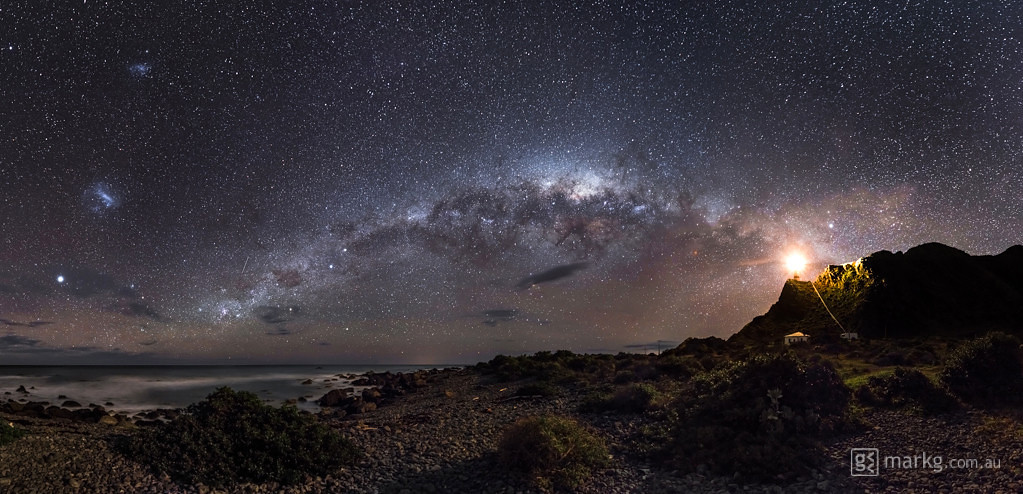 This photo is the winner of the Royal Museums Greenwich astronomy photographer of the year: earth and space category. This is a spectacular view of the Milky Way arching over the coast of the North Island of New Zealand. The brightest light in the image is from the Cape Palliser Lighthouse. The central patch of light in the sky marks the bulge of stars at the heart of our Galaxy, 26,000 light years away. To the left, the two Magellanic Clouds, small satellite galaxies much further away, appear as faint smudges in the sky. The following is a quote from the author, Mark Gee: ‘I recently spent a night out at Cape Palliser on the North Island of New Zealand, photographing the night sky. I woke after a few hours’ sleep at 5 a.m. to see the Milky Way low in the sky above the Cape. The only problem was that my camera gear was at the top of the lighthouse, seen to the right of this image, so I had to climb the 250-plus steps to retrieve it before I could take this photo... ‘By the time I got back the sky was beginning to get lighter with sunrise only two hours away. It looked surreal but amazing as the twilight started to creep into the night sky. I took a wide panorama made up of 20 individual images to get this shot. Stitching the images together was a challenge but the result was worth it!’ Canon 5D Mark III camera; 24mm f/2.8 lens; ISO 3200; 30-second exposure
__________________
1st in Kommisar's 2009 SM Tournament 1st in I Love You`s 2009 New Year`s Tournament 3rd in EnR's Mashfest '08 tournament 5th in Phynx's Unofficial FFR Tournament 9th in D3 of the 2008-2009 4th Official FFR Tournament 10th in D5 of the 2010 5th Official FFR Tournament 10th in D6 of the 2011-2012 6th Official FFR Tournament FMO AAA Count: 71 FGO AAA Count: 10 Bluearrowll = The Canadian player who can not detect awkward patterns. If it's awkward for most people, it's normal for Terry. If the file is difficult but super straight forward, he has issues. If he's AAAing a FGO but then heard that his favorite Hockey team was losing by a point, Hockey > FFR PS: Cool AAA's Terry - I Love You An Alarm Clock's Haiku beep beep beep beep beep beep beep beep beep beep beep beep beep beep beep beep beep - ieatyourlvllol |
|
|

|
|
|
#709 |
|
⊙▃⊙
|
With the return of the US government, the temporary halt on services has been lifted and functionality of this thread that relies on such services can resume. This comes just as a giant meteorite was found over Russia's Chelyabinsk region - exactly where the February 15 blast was earlier this year.
New Feature Added: Whether or not the government would continue to shut down today, I would still have released the meteor tracker today. This Canadian-United States hybrid tracks every single meteor that streaks over North America within a certain brightness - the faintest are not visible to the naked eye. The radiants of each meteor is recorded on a plot, and its velocity is recorded on a second plot to give an idea of how fast it was going. Best of all, it's self updating and only requires a refresh of the browser. You might be surprised just how many meteors pass through this continent alone on any given day! What's in the sky tonight? October 17, 2013 -The bright, nearly full Moon shines below the bottom corner of the Great Square of Pegasus this evening. -The next time you board an airplane with a northern flight path, choose the window seat. Photographer David Mayhew settled in next to the starboard wing of a flight from Denver to Iceland on October 14th, and this is what he saw through the glass. "We were somewhere over the Hudson Bay," says Mayhew. "I rested the lens against the window and held a blanket over my head to reduce reflections - got plenty of odd looks from the other passengers!!" NOAA forecasters estimate a 20% chance of polar geomagnetic storms on Oct. 17th. This means there is at least a 1-in-5 chance of a good view for Arctic fliers. 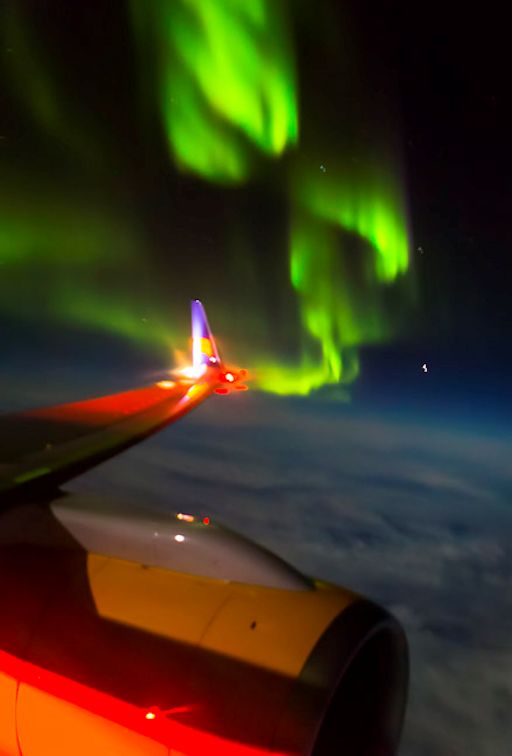 News Posted Today: October 16, 2013 Huge Meteorite Pulled from Russian Lake  Astro Picture of the Day: October 17, 2013  Close to the Great Bear (Ursa Major) and surrounded by the stars of the Hunting Dogs (Canes Venatici), this celestial wonder was discovered in 1781 by the metric French astronomer Pierre Mechain. Later, it was added to the catalog of his friend and colleague Charles Messier as M106. Modern deep telescopic views reveal it to be an island universe: a spiral galaxy around 30 thousand light-years across located only about 21 million light-years beyond the stars of the Milky Way. Along with prominent dust lanes and a bright central core, this colorful composite image highlights youthful blue star clusters and reddish stellar nurseries that trace the galaxy's spiral arms. The high resolution galaxy portrait is a mosaic of data from Hubble's sharp ACS camera combined with groundbased color image data. M106 (aka NGC 4258) is a nearby example of the Seyfert class of active galaxies, seen across the spectrum from radio to X-rays. Energetic active galaxies are powered by matter falling into a massive central black hole.
__________________
1st in Kommisar's 2009 SM Tournament 1st in I Love You`s 2009 New Year`s Tournament 3rd in EnR's Mashfest '08 tournament 5th in Phynx's Unofficial FFR Tournament 9th in D3 of the 2008-2009 4th Official FFR Tournament 10th in D5 of the 2010 5th Official FFR Tournament 10th in D6 of the 2011-2012 6th Official FFR Tournament FMO AAA Count: 71 FGO AAA Count: 10 Bluearrowll = The Canadian player who can not detect awkward patterns. If it's awkward for most people, it's normal for Terry. If the file is difficult but super straight forward, he has issues. If he's AAAing a FGO but then heard that his favorite Hockey team was losing by a point, Hockey > FFR PS: Cool AAA's Terry - I Love You An Alarm Clock's Haiku beep beep beep beep beep beep beep beep beep beep beep beep beep beep beep beep beep - ieatyourlvllol |
|
|

|
|
|
#710 |
|
⊙▃⊙
|
What's in the sky tonight?
October 18, 2013 -Full Moon. A slight penumbral eclipse of the Moon will be detectable this evening by careful Moon-watchers in the eastern half of North America. The Moon will pass deepest through the pale outer fringe (penumbra) of Earth's shadow around 7:50 p.m. Eastern Daylight Time (EDT). Look for unusual shading on the Moon's south-southeastern side. Weaker shading should be detectable for at least 45 minutes before and after. -In Europe and Africa, the penumbral eclipse happens in the middle of the night when the Moon is high: centered on 23:50 Universal Time (GMT). -More cosmic shadow action! A double shadow transit takes place on Jupiter tonight from 6:25 to 8:37 UT October 19th (2:25 to 4:37 a.m. Eastern Daylight Time Saturday morning). Both Io and Europa will be casting their tiny black shadows onto the planet's face at once. Both shadows leave Jupiter's western edge almost simultaneously — just as Europa itself is beginning to cross in front of Jupiter's eastern edge. -During this, Jupiter's Great Red Spot is in view. It should cross the planet's central meridian around 3:25 a.m. EDT Sunday morning. News Posted Today: October 18, 2013 October 18th's Penumbral Lunar Eclipse  Astro Picture of the Day: October 18, 2013 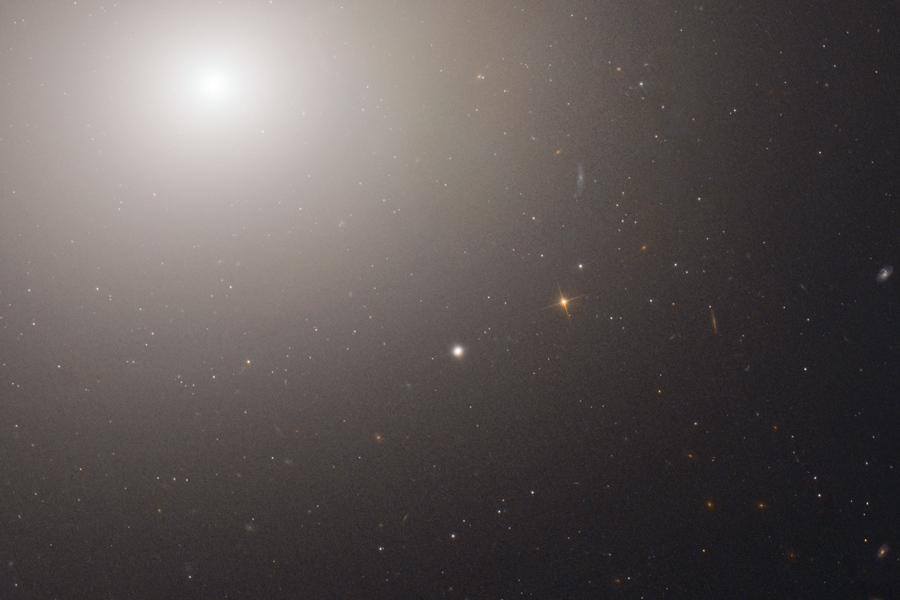 The bright core and outer reaches of giant elliptical galaxy M60 (NGC 4649) loom large at the upper left of this sharp close-up from the Hubble Space Telescope. Some 54 million light-years away and 120,000 light-years across, M60 is one of the largest galaxies in the nearby Virgo Cluster. In cosmic contrast, the small, round smudge at picture center is now recognized as an ultra-compact dwarf galaxy. Cataloged as M60-UCD1, it may well be the densest galaxy in the nearby universe. Concentrating half of its total mass of 200 million suns into a radius of only 80 light-years, stars in the inner regions of M60-UCD1 are on average 25 times closer together than in planet Earth's neighborhood of the Milky Way. Exploring the nature of M60-UCD1, astronomers are trying to determine if ultra-compact dwarf galaxies are the central remnants of larger galaxies that have been tidally stripped by gravitatonal encounters, or evolved as massive globular star clusters. Recently discovered, a bright X-ray source seen at its center could be due to a supermassive black hole. If so, that would favor a remnant galaxy origin for M60-UCD1. A link to the report that claims this is the densest galaxy is found here.
__________________
1st in Kommisar's 2009 SM Tournament 1st in I Love You`s 2009 New Year`s Tournament 3rd in EnR's Mashfest '08 tournament 5th in Phynx's Unofficial FFR Tournament 9th in D3 of the 2008-2009 4th Official FFR Tournament 10th in D5 of the 2010 5th Official FFR Tournament 10th in D6 of the 2011-2012 6th Official FFR Tournament FMO AAA Count: 71 FGO AAA Count: 10 Bluearrowll = The Canadian player who can not detect awkward patterns. If it's awkward for most people, it's normal for Terry. If the file is difficult but super straight forward, he has issues. If he's AAAing a FGO but then heard that his favorite Hockey team was losing by a point, Hockey > FFR PS: Cool AAA's Terry - I Love You An Alarm Clock's Haiku beep beep beep beep beep beep beep beep beep beep beep beep beep beep beep beep beep - ieatyourlvllol |
|
|

|
|
|
#711 |
|
⊙▃⊙
|
What's in the sky tonight?
October 19, 2013 -Look about a fist-width above the Moon this evening for the main stars of little Aries, lined up nearly horizontally. -As Oct. 18th came to a close, a dusky shadow fell across the southern half of the full Hunter's Moon. It was a faint "penumbral" lunar eclipse. Observing from the Canary islands, Frank A. Rodriguez Ramirez photographed the Moon (left) two hours before and (right) at the moment of maximum eclipse. A penumbral eclipse happens when the Moon passes through the pale outskirts of Earth's shadow. It is much less dramatic than a total lunar eclipse. In fact, when observers are not alerted beforehand, they often do not realize an eclipse is underway. Nevertheless, the subtle shadow of Earth is visible to the naked eye if you know it's there. -Usually when there is a lunar eclipse during a full moon, there is a solar eclipse during the subsequent new moon. The trend continues as this lunar eclipse is no exception to the rule - there will be a hybrid solar eclipse on November 3 favouring Africa and the Atlantic Ocean. Depending where you are, in a hybrid eclipse, you will either see an annular eclipse or a total eclipse - the moon will appear large enough eventually to block out all of the sun! 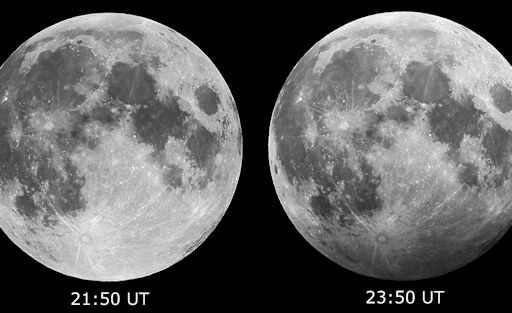 News Posted Today: October 18, 2013 Undue Ado About Asteroid 2013 TV135  Astro Picture of the Day: October 19, 2013 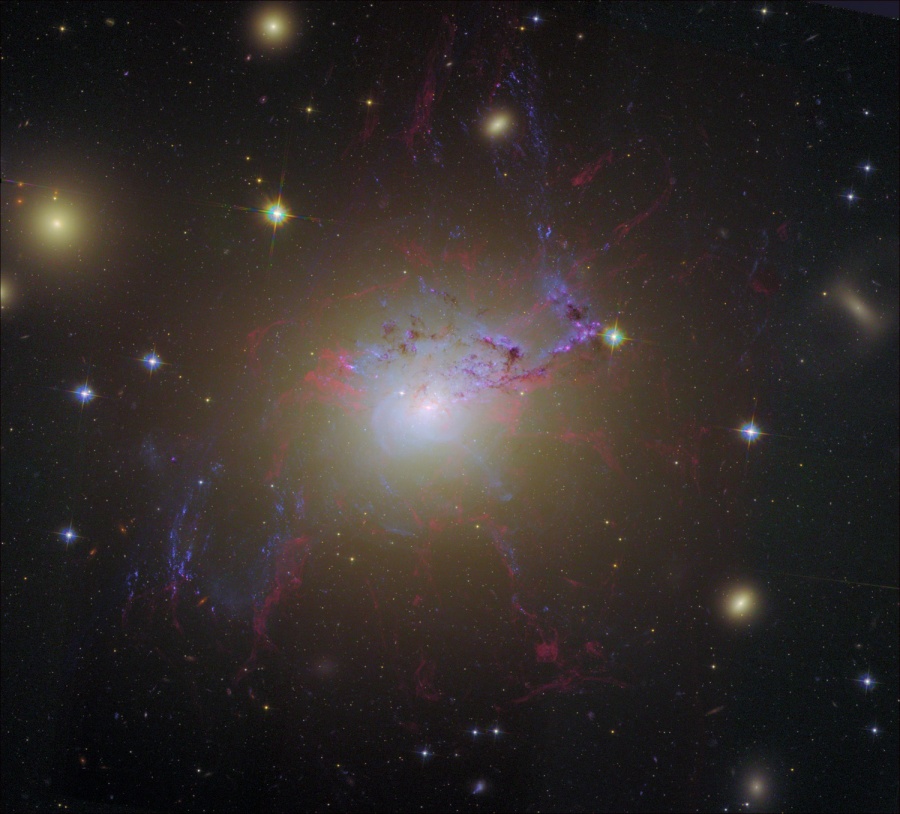 Active galaxy NGC 1275 is the central, dominant member of the large and relatively nearby Perseus Cluster of Galaxies. Wild-looking at visible wavelengths, the active galaxy is also a prodigious source of x-rays and radio emission. NGC 1275 accretes matter as entire galaxies fall into it, ultimately feeding a supermassive black hole at the galaxy's core. This color composite image, recreated from archival Hubble Space Telescope data, highlights the resulting galactic debris and filaments of glowing gas, some up to 20,000 light-years long. The filaments persist in NGC 1275, even though the turmoil of galactic collisions should destroy them. What keeps the filaments together? Observations indicate that the structures, pushed out from the galaxy's center by the black hole's activity, are held together by magnetic fields. Also known as Perseus A, NGC 1275 spans over 100,000 light years and lies about 230 million light years away.
__________________
1st in Kommisar's 2009 SM Tournament 1st in I Love You`s 2009 New Year`s Tournament 3rd in EnR's Mashfest '08 tournament 5th in Phynx's Unofficial FFR Tournament 9th in D3 of the 2008-2009 4th Official FFR Tournament 10th in D5 of the 2010 5th Official FFR Tournament 10th in D6 of the 2011-2012 6th Official FFR Tournament FMO AAA Count: 71 FGO AAA Count: 10 Bluearrowll = The Canadian player who can not detect awkward patterns. If it's awkward for most people, it's normal for Terry. If the file is difficult but super straight forward, he has issues. If he's AAAing a FGO but then heard that his favorite Hockey team was losing by a point, Hockey > FFR PS: Cool AAA's Terry - I Love You An Alarm Clock's Haiku beep beep beep beep beep beep beep beep beep beep beep beep beep beep beep beep beep - ieatyourlvllol |
|
|

|
|
|
#712 |
|
⊙▃⊙
|
What's in the sky tonight?
October 20, 2013 -This week, face southwest soon after dark and look high for Altair. It's the bright eye of Aquila, the Eagle, most of which now hangs down below it. Look to Altair's upper left, by about a fist and a half at arm's length, for little Delphinus, the Dolphin, leaping upward. -Look almost as far to Altair's upper right for Sagitta, the Arrow, even fainter and smaller. -Tonight a star will be occulted by a pair of asteroids, 617 Patroclus. The last time this occured was in 2011 where amateur astronomers combined their data to successfully form a picture of the asteroids based off when the star disappeared from their respective location. Read the news for more details of tonights event.  News Posted Today: October 19, 2013 (Maybe) Watch a Binary Asteroid "Wink Out"  Astro Picture of the Day: October 20, 2013  To the eye, this cosmic composition nicely balances the Bubble Nebula at the lower left with open star cluster M52 above it and to the right. The pair would be lopsided on other scales, though. Embedded in a complex of interstellar dust and gas and blown by the winds from a single, massive O-type star, the Bubble Nebula, also known as NGC 7635, is a mere 10 light-years wide. On the other hand, M52 is a rich open cluster of around a thousand stars. The cluster is about 25 light-years across. Seen toward the northern boundary of Cassiopeia, distance estimates for the Bubble Nebula and associated cloud complex are around 11,000 light-years, while star cluster M52 lies nearly 5,000 light-years away. The wide telescopic field of view spans about two degrees on the sky or four times the apparent size of the Full Moon.
__________________
1st in Kommisar's 2009 SM Tournament 1st in I Love You`s 2009 New Year`s Tournament 3rd in EnR's Mashfest '08 tournament 5th in Phynx's Unofficial FFR Tournament 9th in D3 of the 2008-2009 4th Official FFR Tournament 10th in D5 of the 2010 5th Official FFR Tournament 10th in D6 of the 2011-2012 6th Official FFR Tournament FMO AAA Count: 71 FGO AAA Count: 10 Bluearrowll = The Canadian player who can not detect awkward patterns. If it's awkward for most people, it's normal for Terry. If the file is difficult but super straight forward, he has issues. If he's AAAing a FGO but then heard that his favorite Hockey team was losing by a point, Hockey > FFR PS: Cool AAA's Terry - I Love You An Alarm Clock's Haiku beep beep beep beep beep beep beep beep beep beep beep beep beep beep beep beep beep - ieatyourlvllol Last edited by Bluearrowll; 10-20-2013 at 09:06 AM.. |
|
|

|
|
|
#713 |
|
⊙▃⊙
|
What's in the sky tonight?
October 21, 2013 -Lonely Fomalhaut, the Autumn Star, is at its highest in the south around 9 or 10 p.m. this week. -Earth is passing through a stream of debris from Halley's Comet, source of the annual Orionid meteor shower. Forecasters expect the shower to peak on Monday, Oct. 21st, with about 20 meteors per hour. The best time to look is during the hours before local sunrise when the constellation Orion is high in the sky. -Lunar interference will be a problem during the peak. All but the brightest Orionids will be wiped out by glare from the waning full Moon. Fortunately there are some bright ones. NASA's All Sky Fireball Network captured this Orionid fireball shining through the moonlight over Georgia on the morning of Oct. 20th: http://www.spaceweather.com/images20...60126A_04A.avi Astro Picture of the Day: October 21, 2013 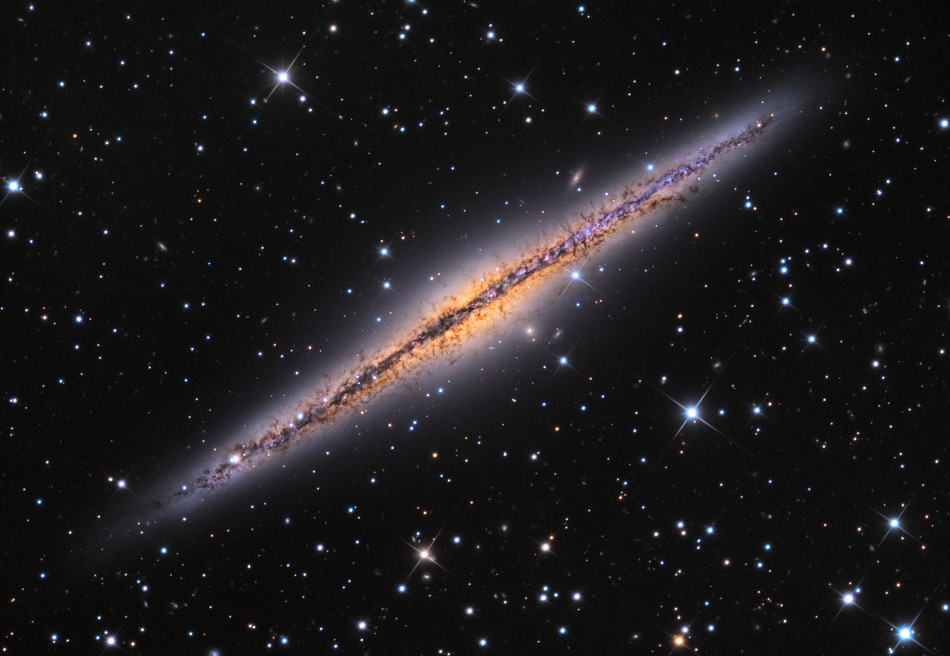 This sharp cosmic portrait features NGC 891. The spiral galaxy spans about 100 thousand light-years and is seen almost exactly edge-on from our perspective. In fact, about 30 million light-years distant in the constellation Andromeda, NGC 891 looks a lot like our Milky Way. At first glance, it has a flat, thin, galactic disk and a central bulge cut along the middle by regions of dark obscuring dust. The combined image data also reveal the galaxy's young blue star clusters and telltale pinkish star forming regions. And remarkably apparent in NGC 891's edge-on presentation are filaments of dust that extend hundreds of light-years above and below the center line. The dust has likely been blown out of the disk by supernova explosions or intense star formation activity. Faint neighboring galaxies can also be seen near this galaxy's disk.
__________________
1st in Kommisar's 2009 SM Tournament 1st in I Love You`s 2009 New Year`s Tournament 3rd in EnR's Mashfest '08 tournament 5th in Phynx's Unofficial FFR Tournament 9th in D3 of the 2008-2009 4th Official FFR Tournament 10th in D5 of the 2010 5th Official FFR Tournament 10th in D6 of the 2011-2012 6th Official FFR Tournament FMO AAA Count: 71 FGO AAA Count: 10 Bluearrowll = The Canadian player who can not detect awkward patterns. If it's awkward for most people, it's normal for Terry. If the file is difficult but super straight forward, he has issues. If he's AAAing a FGO but then heard that his favorite Hockey team was losing by a point, Hockey > FFR PS: Cool AAA's Terry - I Love You An Alarm Clock's Haiku beep beep beep beep beep beep beep beep beep beep beep beep beep beep beep beep beep - ieatyourlvllol |
|
|

|
|
|
#714 |
|
⊙▃⊙
|
What's in the sky tonight?
October 22, 2013 -Venus (magnitude –4.4) shines brightly in the southwest during dusk, gradually moving higher week by week. Can you still see Antares moving farther to its lower right? In a telescope Venus is nearing dichotomy, when it will appear exactly half-lit. -Almost 450 million km from Earth, Comet C/2012 X1 (LINEAR) has exploded. Amateur astronomers are reporting a 200-fold increase in the comet's brightness on Oct. 20th, and the comet's atmosphere or "coma" now resembles that of exploding Comet 17P/Holmes in 2007. Using a remotely-controlled 0.5 meter telescope in New Mexico, European observers Ernesto Guido, Martino Nicolini and Nick Howes took this picture of the spherical explosion on Oct 21st. "The predicted magnitude of the comet, pre-outburst, was about +14," says Guido. "Now it is close to +8.5." This is below the threshold for naked-eye visibility, but bright enough for backyard telescopes equipped with digital cameras. Prompted by the reports of Guido et al, Romanian amateur astronomer Maximilian Teodorescu observed the comet on Oct. 22nd, confirming its brightness and spherical structure: image. "It looked exactly like Comet Holmes back in 2007," says Teodorescu. Located in the constellation Coma Berenices, Comet LINEAR X1 rises in the east about an hour before the sun. The low altitude of the comet in morning twilight is a challenge. "I could not see the comet through the eyepiece of my 4.5 inch refracting telescope," adds Teodorescu, "but the camera detected it easily enough." The comet could become brighter in the days ahead as its coma expands. Monitoring is encouraged. -The Canadian Meteor Orbit Radar (CMOR) is still detecting echoes from Orionid meteors. This means Earth is still inside a stream of debris from the shower's parent comet, Halley. A CMOR sky map made at 04:15 UT on Oct. 22nd shows the Orionid radiant (ORI) clearly active. Forecasters expected the shower to peak on Oct. 21st with about 20 meteors per hour. However, Halley's debris stream is so broad that Orionid activity has spilled into Oct. 22nd. If you're up before sunrise, be alert for meteors! 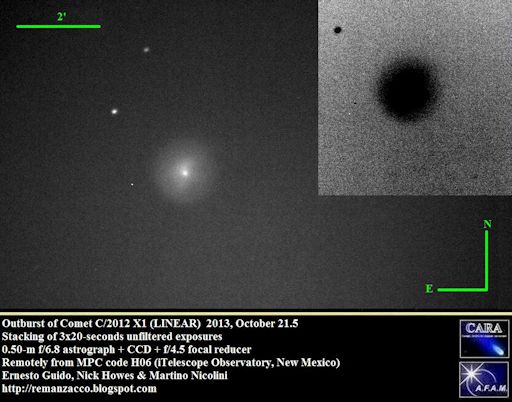 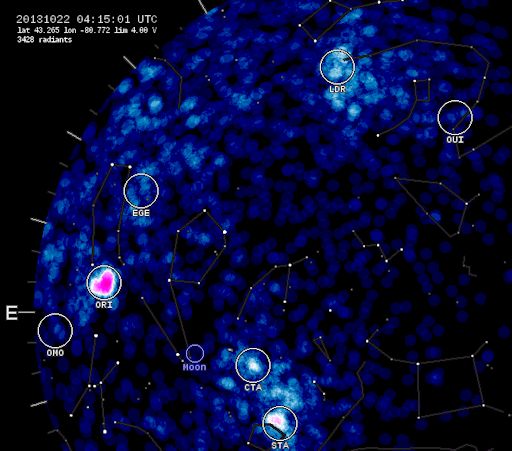 Astro Picture of the Day: October 22, 2013 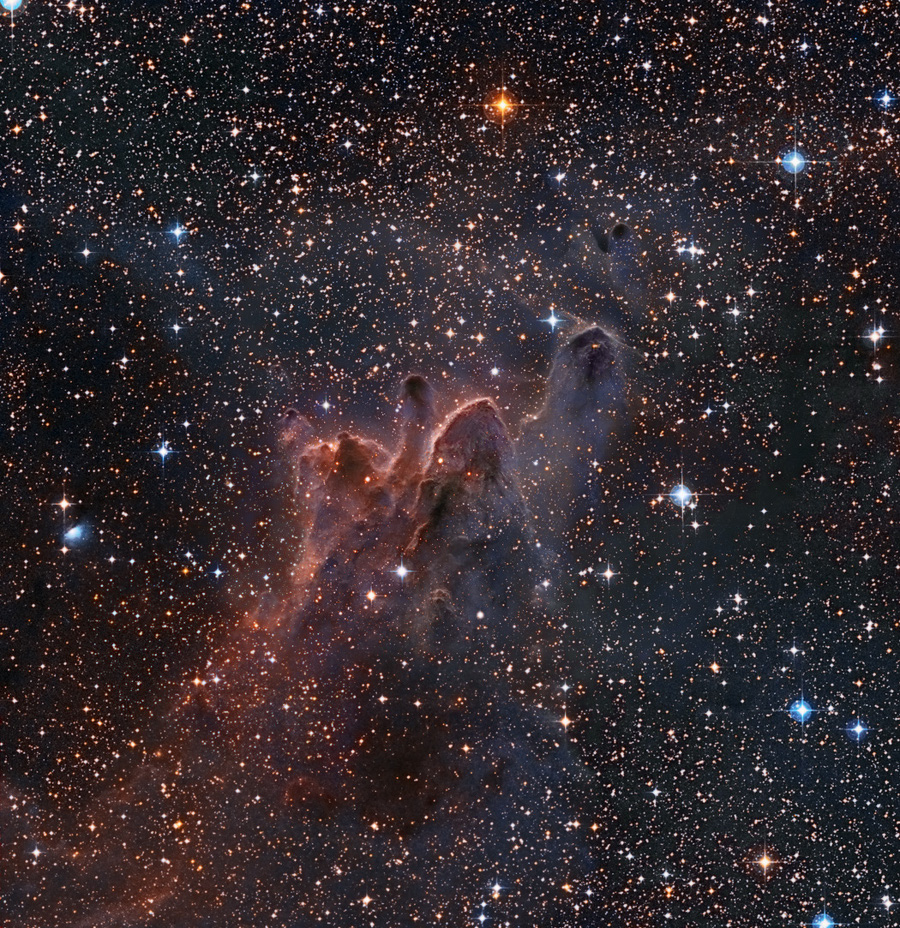 Bright-rimmed, flowing shapes gather near the center of this rich starfield toward the boarders of the nautical southern constellations Pupis and Vela. Composed of interstellar gas and dust, the grouping of light-year sized cometary globules is about 1300 light-years distant. Energetic ultraviolet light from nearby hot stars has molded the globules and ionized their bright rims. The globules also stream away from the Vela supernova remnant which may have influenced their swept-back shapes. Within them, cores of cold gas and dust are likely collapsing to form low mass stars, whose formation will ultimately cause the globules to disperse. In fact, cometary globule CG30 (upper right in the group) sports a small reddish glow near its head, a telltale sign of energetic jets from a star in the early stages of formation.
__________________
1st in Kommisar's 2009 SM Tournament 1st in I Love You`s 2009 New Year`s Tournament 3rd in EnR's Mashfest '08 tournament 5th in Phynx's Unofficial FFR Tournament 9th in D3 of the 2008-2009 4th Official FFR Tournament 10th in D5 of the 2010 5th Official FFR Tournament 10th in D6 of the 2011-2012 6th Official FFR Tournament FMO AAA Count: 71 FGO AAA Count: 10 Bluearrowll = The Canadian player who can not detect awkward patterns. If it's awkward for most people, it's normal for Terry. If the file is difficult but super straight forward, he has issues. If he's AAAing a FGO but then heard that his favorite Hockey team was losing by a point, Hockey > FFR PS: Cool AAA's Terry - I Love You An Alarm Clock's Haiku beep beep beep beep beep beep beep beep beep beep beep beep beep beep beep beep beep - ieatyourlvllol |
|
|

|
|
|
#715 |
|
⊙▃⊙
|
What's in the sky tonight?
October 23, 2013 - Fast-growing sunspot AR1875 has developed a 'beta-gamma-delta' magnetic field that harbors energy strong explosions. NOAA forecasters estimate a 30% chance of M-class solar flares and a 5% chance of X-flares on Oct. 23rd. -During the early hours of Oct. 22nd, a long filament of magnetism erupted on the sun. The explosion hurled a lopsided CME into space, and a new analysis suggests it could be Earth-directed. The eruption occured squarely on the Earthside of the sun, but the CME is not squarely Earth-directed. The bulk of the ejecta will fly north of the sun-Earth line. Nevertheless, the CME is expected to deliver a glancing blow to Earth's magnetic field on Oct. 24-25. It might even merge with a pair of minor CMEs traveling ahead of it. If so, the combined impact would be more likely to spark a geomagnetic storm. High-latitude sky watchers should be alert for auroras in the nights ahead. -Every night, a network of NASA all-sky cameras scans the skies above the United States for meteoritic fireballs [brighter than Venus or magnitude -4]. Automated software maintained by NASA's Meteoroid Environment Office calculates their orbits, velocity, penetration depth in Earth's atmosphere and many other characteristics. Daily results are presented on Spaceweather.com. On Oct. 22, 2013, the network reported 38 fireballs. In this diagram of the inner solar system, all of the fireball orbits intersect at a single point - Earth. The orbits are color-coded by velocity, from slow (red) to fast (blue). 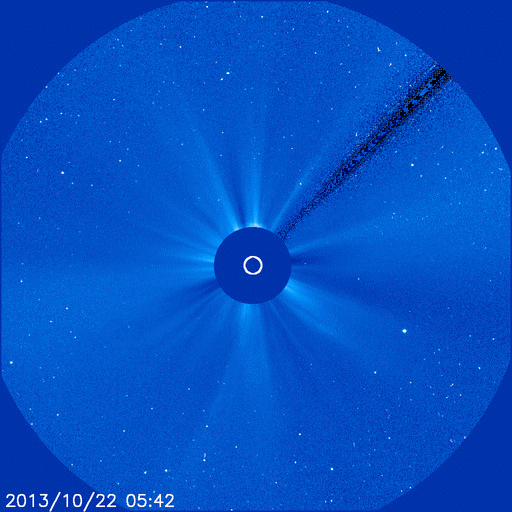  Astro Picture of the Day: October 23, 2013 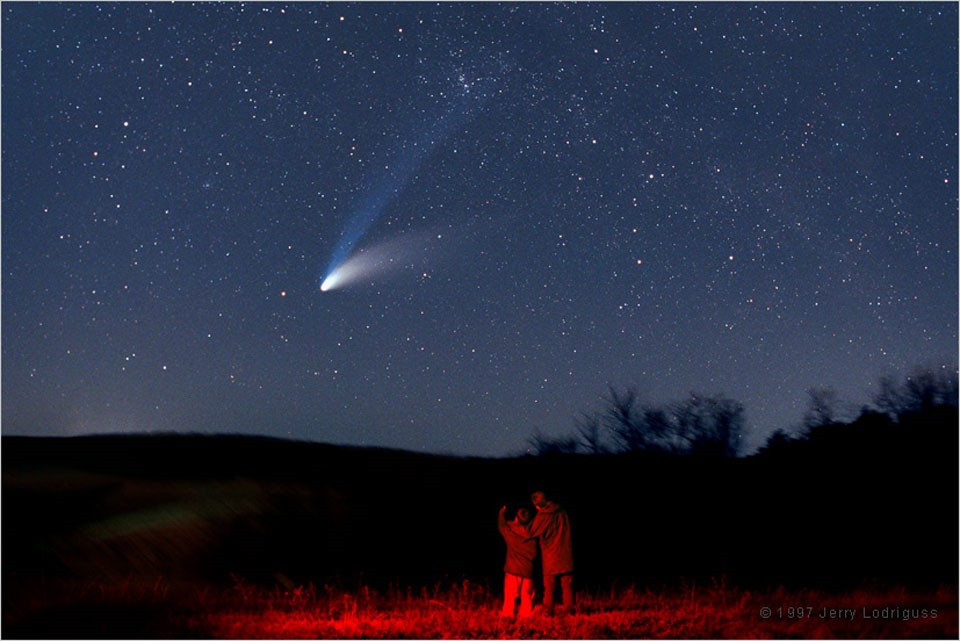 Sixteen years ago, Comet Hale-Bopp rounded the Sun and offered a dazzling spectacle in planet Earth's night. This stunning view, recorded shortly after the comet's 1997 perihelion passage, features the memorable tails of Hale-Bopp - a whitish dust tail and blue ion tail. Here, the ion tail extends well over ten degrees across the northern sky, fading near the double star clusters in Perseus, while the head of the comet lies near Almach, a bright star in the constellation Andromeda. Do you remember Hale-Bopp? The photographer's sons do, pictured in the foreground at ages 12 and 15. In all, Hale-Bopp was reported as visible to the naked eye from roughly late May 1996 through September 1997. Currently, sky enthusiasts await Comet ISON's continued brightening in the coming weeks, unsure how interesting its first journey to the inner Solar System will be.
__________________
1st in Kommisar's 2009 SM Tournament 1st in I Love You`s 2009 New Year`s Tournament 3rd in EnR's Mashfest '08 tournament 5th in Phynx's Unofficial FFR Tournament 9th in D3 of the 2008-2009 4th Official FFR Tournament 10th in D5 of the 2010 5th Official FFR Tournament 10th in D6 of the 2011-2012 6th Official FFR Tournament FMO AAA Count: 71 FGO AAA Count: 10 Bluearrowll = The Canadian player who can not detect awkward patterns. If it's awkward for most people, it's normal for Terry. If the file is difficult but super straight forward, he has issues. If he's AAAing a FGO but then heard that his favorite Hockey team was losing by a point, Hockey > FFR PS: Cool AAA's Terry - I Love You An Alarm Clock's Haiku beep beep beep beep beep beep beep beep beep beep beep beep beep beep beep beep beep - ieatyourlvllol |
|
|

|
|
|
#716 |
|
⊙▃⊙
|
What's in the sky tonight?
October 24, 2013 - The Moon rises around 10 or 11 tonight (depending on where you are), with bright Jupiter to its left or lower left. Farther left is Pollux, with Castor above it. By the beginning of dawn Friday morning, they're all high in the south (above Procyon). -Earth's magnetic field is about to receive a glancing blow from three CMEs observed leaving the Sun between Oct. 20th and 22nd. Forecast models suggest that the three clouds merged en route to Earth, and their combined impact could trigger a mild polar geomagnetic storm on Oct. 24-25. High-latitude sky watchers should be alert for auroras. -Solar activity is high. On October 24th at 00:30 UT, Earth-facing sunspot AR1877 erupted, producing a powerful M9-class solar flare. The eruption hurled a faint CME into space and it appears to be heading toward Earth. The arrival time is not yet known. More flares are in the offing. Two large sunspots, AR1875 and AR1877, have 'beta-gamma-delta' magnetic fields that harbor energy for strong eruptions. NOAA forecasters estimate a 40% chance of M-flares and a 5% chance of X-flares during the next 24 hours. 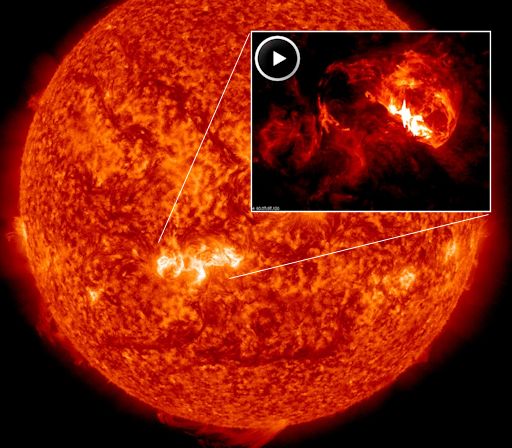 Astro Picture of the Day: October 24, 2013  This intriguing trio of galaxies is sometimes called the Draco Group, located in the northern constellation of (you guessed it) Draco. From left to right are edge-on spiral NGC 5981, elliptical galaxy NGC 5982, and face-on spiral NGC 5985 - all within this single telescopic field of view spanning a little more than half the width of the full moon. While the group is far too small to be a galaxy cluster and has not been catalogued as a compact group, these galaxies all do lie roughly 100 million light-years from planet Earth. On close examination with spectrographs, the bright core of the striking face-on spiral NGC 5985 shows prominent emission in specific wavelengths of light, prompting astronomers to classify it as a Seyfert, a type of active galaxy. Not as well known as other tight groupings of galaxies, the contrast in visual appearance makes this triplet an attractive subject for astrophotographers. This impressively deep exposure hints at faint, sharp-edged shells surrounding elliptical NGC 5982, evidence of past galactic mergers. It also reveals many even more distant background galaxies.
__________________
1st in Kommisar's 2009 SM Tournament 1st in I Love You`s 2009 New Year`s Tournament 3rd in EnR's Mashfest '08 tournament 5th in Phynx's Unofficial FFR Tournament 9th in D3 of the 2008-2009 4th Official FFR Tournament 10th in D5 of the 2010 5th Official FFR Tournament 10th in D6 of the 2011-2012 6th Official FFR Tournament FMO AAA Count: 71 FGO AAA Count: 10 Bluearrowll = The Canadian player who can not detect awkward patterns. If it's awkward for most people, it's normal for Terry. If the file is difficult but super straight forward, he has issues. If he's AAAing a FGO but then heard that his favorite Hockey team was losing by a point, Hockey > FFR PS: Cool AAA's Terry - I Love You An Alarm Clock's Haiku beep beep beep beep beep beep beep beep beep beep beep beep beep beep beep beep beep - ieatyourlvllol |
|
|

|
|
|
#717 |
|
⊙▃⊙
|
What's in the sky tonight?
October 25, 2013 -Solar activity is intensifying. New sunspot AR1882, which rotated over the sun's eastern limb earlier today, promptly unleashed an X1-class solar flare, adding to a days-long fusillade of flares already underway from sunspots AR1875 and AR1877. NASA's Solar Dynamics Observatory recorded a bright flash of extreme UV radiation from the X1 flare, which peaked at 08:01 UT on Oct. 25th. There may be more to this flare than meets the eye. Watch this movie below of the sun's entire disk. The X1-flare was bracketed by two erupting magnetic filaments, each located hundreds of thousands of kilometers from AR1882. In other words, the X1 flare might have been just one piece of an interconnected global eruption. More flares are in the offing. There are now three sunspot groups on the Earthside of the sun capable of strong eruptions: AR1875, AR1877 and AR1882. NOAA forecasters estimate a 55% chance of M-flares and a 10% chance of X-flares during the next 24 hours. -Keep an eye to the low east-northeast for Jupiter rising around 11 or midnight (depending on your location). Castor and Pollux shine to its left. About 45 minutes later, the waning gibbous Moon follows it up. And then once the Moon is well up, look to the Moon's lower right for Procyon. 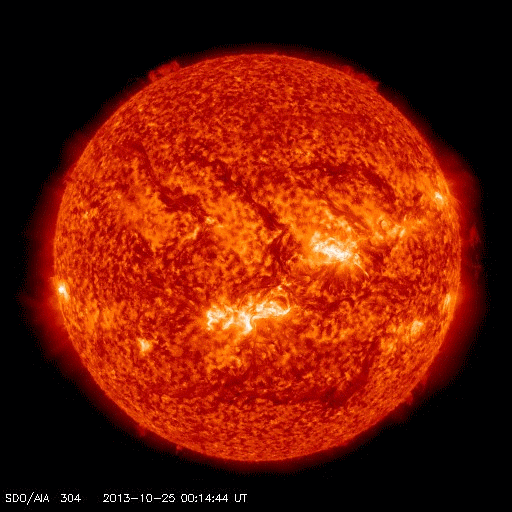 Astro Picture of the Day: October 25, 2013  The bulging center of our Milky Way Galaxy rests on a pillar of light in this luminous skyscape. Recorded on September 22nd in dark South African skies, rivers of dust seem to flow downward from the galactic center towards Antares, yellowish alpha star of the constellation Scorpius, near the top of the scene. The brightest celestial beacon present is not a star at all though, but planet Venus, still dominant in the western sky after sunset. Of course, the pillar of light stretching upward from the horizon is Zodiacal light. Sunlight scattered by dust along the plane of the ecliptic creates the zodiacal glow, prominent in the evening after twilight during the southern hemisphere spring.
__________________
1st in Kommisar's 2009 SM Tournament 1st in I Love You`s 2009 New Year`s Tournament 3rd in EnR's Mashfest '08 tournament 5th in Phynx's Unofficial FFR Tournament 9th in D3 of the 2008-2009 4th Official FFR Tournament 10th in D5 of the 2010 5th Official FFR Tournament 10th in D6 of the 2011-2012 6th Official FFR Tournament FMO AAA Count: 71 FGO AAA Count: 10 Bluearrowll = The Canadian player who can not detect awkward patterns. If it's awkward for most people, it's normal for Terry. If the file is difficult but super straight forward, he has issues. If he's AAAing a FGO but then heard that his favorite Hockey team was losing by a point, Hockey > FFR PS: Cool AAA's Terry - I Love You An Alarm Clock's Haiku beep beep beep beep beep beep beep beep beep beep beep beep beep beep beep beep beep - ieatyourlvllol |
|
|

|
|
|
#718 |
|
⊙▃⊙
|
What's in the sky tonight?
October 26, 2013 -Last-quarter Moon (exact at 7:40 p.m. EDT). The Moon rises around midnight or 1 a.m. local time tonight, in dim Cancer below Jupiter and Gemini. To the right of the Moon and Jupiter, Procyon forms a nearly equilateral triangle with them. -By dawn on Sunday they're all high in the southeast to south, with Procyon now on the bottom and Regulus and Mars off to their lower left. -New sunspot AR1882 isn't very big, but it is potent. The active region has already unleashed two strong solar flares today: An X1 at 08:01 UT followed by an X2 at 15:07 UT. There is no reason to think this fusillade will end soon, so stay tuned for more flares. -Electromagnetic radiation from today's X2-class solar flare had a significant effect on Earth's upper atmosphere. As a wave of ionization swept across the dayside of the planet, the normal propagation of shortwave radio signals was scrambled. In Alachua, Florida, electrical engineer Wes Greenman recorded the effects using his own shortwave radio telescope. The results are the animation below. -During the time that terrestrial shortwave transmissions were blacked out, the sun filled in the gap with a loud radio burst of its own. In New Mexico, amateur radio astronomer Thomas Ashcraft recorded the sounds. "This radio burst was a strong one and might be too intense for headphones," cautions Ashcraft. Here is the link to the audio of what an X-Flare explosion would sound like: caution: Loud. http://www.spaceweather.com/images20...z_Ashcraft.mp3 Solar radio bursts are caused by strong shock waves moving through the sun's atmosphere. (Electrons accelerated by the shock front excite plasma instabilities which, in turn, produce shortwave static.) They are usually a sign that a CME is emerging from the blast site - and indeed this flare produced a very bright CME. 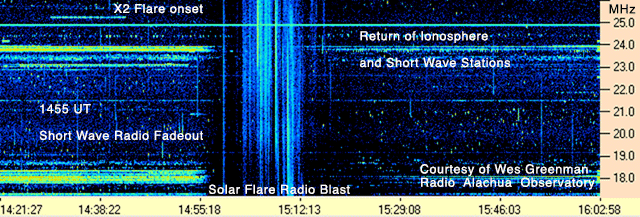  Astro Picture of the Day: October 26, 2013  Diffuse starlight and dark nebulae along the southern Milky Way arc over the horizon and sprawl diagonally through this gorgeous nightscape. The breath-taking mosaic spans a wide 100 degrees, with the rugged terrain of the Patagonia, Argentina region in the foreground. Along with the insider's view of our own galaxy, the image features our outside perspective on two irregular satellite galaxies - the Large and Small Magellanic Clouds. The scene also captures the broad tail and bright coma of Comet McNaught, the Great Comet of 2007. Currently, many sky enthusiasts are following the development of Comet ISON, a comet which might become the Great Comet of 2013.
__________________
1st in Kommisar's 2009 SM Tournament 1st in I Love You`s 2009 New Year`s Tournament 3rd in EnR's Mashfest '08 tournament 5th in Phynx's Unofficial FFR Tournament 9th in D3 of the 2008-2009 4th Official FFR Tournament 10th in D5 of the 2010 5th Official FFR Tournament 10th in D6 of the 2011-2012 6th Official FFR Tournament FMO AAA Count: 71 FGO AAA Count: 10 Bluearrowll = The Canadian player who can not detect awkward patterns. If it's awkward for most people, it's normal for Terry. If the file is difficult but super straight forward, he has issues. If he's AAAing a FGO but then heard that his favorite Hockey team was losing by a point, Hockey > FFR PS: Cool AAA's Terry - I Love You An Alarm Clock's Haiku beep beep beep beep beep beep beep beep beep beep beep beep beep beep beep beep beep - ieatyourlvllol |
|
|

|
|
|
#719 |
|
⊙▃⊙
|
What's in the sky tonight?
October 27, 2013 -Halloween is approaching, and this means that Arcturus, the star sparkling low in the west-northwest in twilight, is taking on its role as "the Ghost of Summer Suns." For several days centered on October 29th every year, Arcturus occupies a special place above your local landscape. It closely marks the spot in your sky where the Sun stood at the same time, by the clock, during warm June and July — in broad daylight, of course. So, in the last days of October each year, you can think of Arcturus as the chilly Halloween ghost of the departed summer Sun. - On Oct. 20th, amateur astronomers realized that the comet's brightness had increased 100-fold and its morphology resembled that of exploding Comet 17P/Holmes in 2007. Follow-up images in recent nights seem to show jet-like structures in Comet LINEAR X1's expanding atmosphere. Amateur astronomer Nick James of Chelmsford, UK, obtained the data on below Oct. 26th. Another set of images taken by James shows the comet's atmosphere or "coma" expanding over a period of two days. "The coma's diameter is increasing at a rate of 30 arcseconds per day," says James. "At a distance of 2.95 AU this corresponds to 65,000 km/day or a little less than 1 km/s." He made these observations using an 11-inch Celestron telescope. Located in the constellation Coma Berenices, Comet LINEAR X1 rises in the east about an hour before the sun. The low altitude of the comet in morning twilight is a challenge, but because the comet is fairly bright, magnitude +8.5, it is still a relatively easy target for backyard telescopes equipped with digital cameras. Monitoring is encouraged! 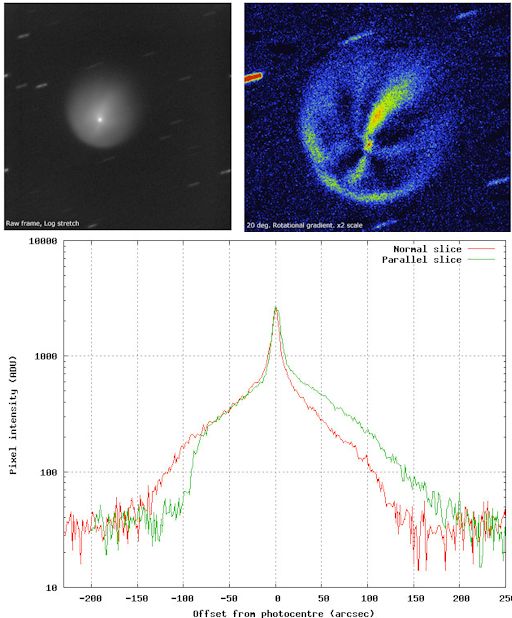 Astro Picture of the Day: October 27, 2013  This image of Saturn could not have been taken from Earth. No Earth based picture could possibly view the night side of Saturn and the corresponding shadow cast across Saturn's rings. Since Earth is much closer to the Sun than Saturn, only the day side of the ringed planet is visible from the Earth. In fact, this image mosaic was taken earlier this month by the robotic Cassini spacecraft now orbiting Saturn. The beautiful rings of Saturn are seen in full expanse, while cloud details are visible including the polar hexagon surrounding the north pole, and an extended light-colored storm system.
__________________
1st in Kommisar's 2009 SM Tournament 1st in I Love You`s 2009 New Year`s Tournament 3rd in EnR's Mashfest '08 tournament 5th in Phynx's Unofficial FFR Tournament 9th in D3 of the 2008-2009 4th Official FFR Tournament 10th in D5 of the 2010 5th Official FFR Tournament 10th in D6 of the 2011-2012 6th Official FFR Tournament FMO AAA Count: 71 FGO AAA Count: 10 Bluearrowll = The Canadian player who can not detect awkward patterns. If it's awkward for most people, it's normal for Terry. If the file is difficult but super straight forward, he has issues. If he's AAAing a FGO but then heard that his favorite Hockey team was losing by a point, Hockey > FFR PS: Cool AAA's Terry - I Love You An Alarm Clock's Haiku beep beep beep beep beep beep beep beep beep beep beep beep beep beep beep beep beep - ieatyourlvllol |
|
|

|
|
|
#720 |
|
⊙▃⊙
|
What's in the sky tonight?
October 28, 2013 -Algol in Perseus, the prototype eclipsing binary star, should be in one of its periodic dimmings, magnitude 3.4 instead of its usual 2.1, for a couple hours centered on 1:46 a.m. Tuesday morning EDT (10:46 p.m. Monday evening PDT). Algol takes several additional hours to fade and to rebrighten. Use the comparison-star chart at right. -Through the early morning hours and into dawn Tuesday morning, the waning crescent Moon forms a triangle with Mars and Regulus in the eastern sky — for the second time this month. By dawn it's high in the southeast. -Earth-orbiting satellites detected an X1-class solar flare from sunspot AR1875 on Oct. 28th at 0203 UT. This is the 3rd X-flare since Oct. 25th, which means solar activity is still high.  Astro Picture of the Day: October 28, 2013 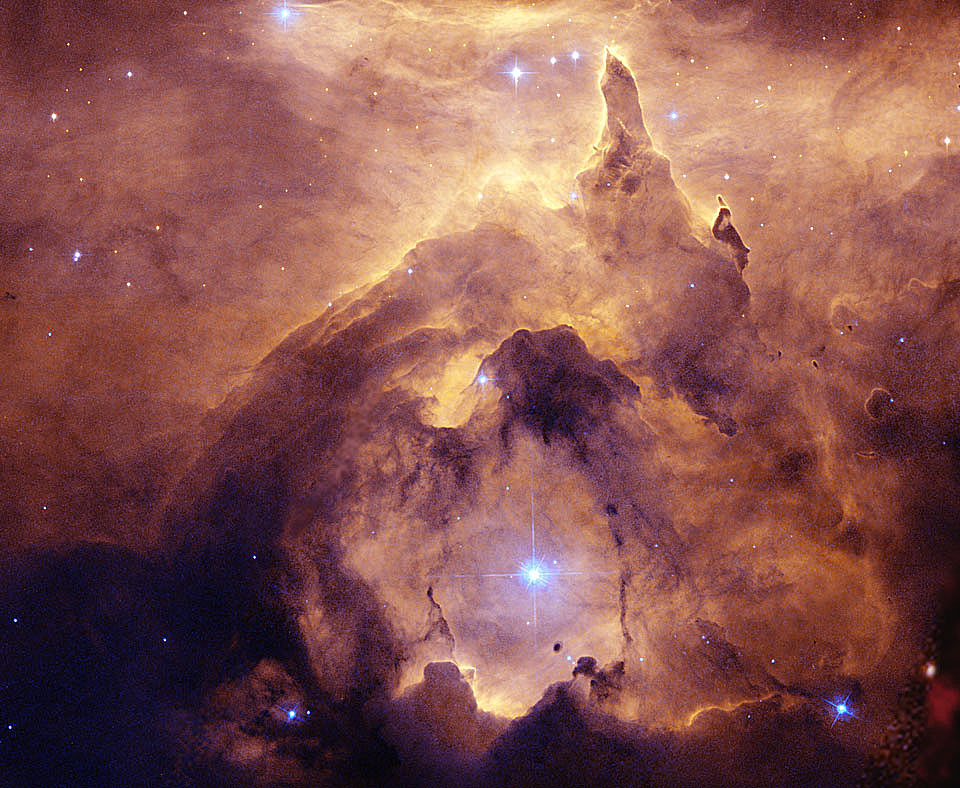 For reasons unknown, NGC 6357 is forming some of the most massive stars ever discovered. One such massive star, near the center of NGC 6357, is framed above carving out its own interstellar castle with its energetic light from surrounding gas and dust. In the greater nebula, the intricate patterns are caused by complex interactions between interstellar winds, radiation pressures, magnetic fields, and gravity. The overall glow of the nebula results from the emission of light from ionized hydrogen gas. Near the more obvious Cat's Paw nebula, NGC 6357 houses the open star cluster Pismis 24, home to many of these tremendously bright and blue stars. The central part of NGC 6357 shown spans about 10 light years and lies about 8,000 light years away toward the constellation of the Scorpion.
__________________
1st in Kommisar's 2009 SM Tournament 1st in I Love You`s 2009 New Year`s Tournament 3rd in EnR's Mashfest '08 tournament 5th in Phynx's Unofficial FFR Tournament 9th in D3 of the 2008-2009 4th Official FFR Tournament 10th in D5 of the 2010 5th Official FFR Tournament 10th in D6 of the 2011-2012 6th Official FFR Tournament FMO AAA Count: 71 FGO AAA Count: 10 Bluearrowll = The Canadian player who can not detect awkward patterns. If it's awkward for most people, it's normal for Terry. If the file is difficult but super straight forward, he has issues. If he's AAAing a FGO but then heard that his favorite Hockey team was losing by a point, Hockey > FFR PS: Cool AAA's Terry - I Love You An Alarm Clock's Haiku beep beep beep beep beep beep beep beep beep beep beep beep beep beep beep beep beep - ieatyourlvllol |
|
|

|
 |
| Currently Active Users Viewing This Thread: 1 (0 members and 1 guests) | |
|
|